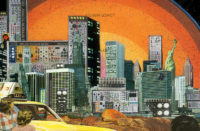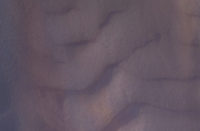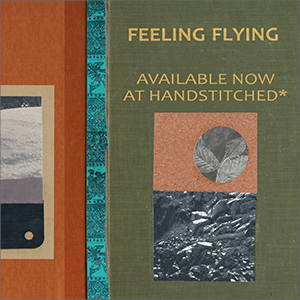
(08.17.07) This is the debut of a new monthly review column by TJ
Norris. The focus will be fixated on charged international releases
that play on audio/visual elements and experiments within the hybrid
of multi genres. Like ions this type of charge can unknowingly produce
both positive and negative effects. Norris is also continuing to
curate a somewhat related a/v performance series, soundbytes, in his
native Portland, Oregon. In the past he has hosted diverse acts as
Twine, Illusion of Safety, Richard Francis and vidnaObmana. If you are
passing through please contact him for more information, or read his
regular blog to get the double-dipped flavor of the month.
::..:::…..:..::….:::::..:::..:::::::……:::…::.:::….::::..:..:::…::…….::::
By using field recordings and incorporating dulcimer and other
percussive steel instruments, these two collaborators have woven an
off-putting montage of high pitch and low tone. Most of what is heard
here is not at all in the realm of the minimalism and ambience
customarily found in the discographies of these artists. Bernhard
Günter and Heribert Friedl create a creaking, dragging sensibility
with this heavily embellished forty-four minute blend of coarse drones
and fingers-to-chalkboard effected shrieks. The uneasy listening
experience has a deep suspense that infers cinema and yet remains
withdrawn. Embedded is the synthesis of conundrum between a would-be
symphony and real-time cacophony.
::..:::…..:..::….:::::..:::..:::::::……:::…::.:::….::::..:..:::…::…….::::
The debut recording from the duo of Russell Haswell and Florian Hecker
is a rift on the UPIC sound system conceived by composer Iannis
Xenakis. These multimedia artists employ visual drawing tablet tools
to develop their compositions, which delve into a cursive, buzzing
template of craggy noise editing, forming abstract pieces that hiss
and shake. With the technology at hand, these former recipients of the
prestigious Prix Ars Electronica, follow in the footsteps of filmmaker
Oskar Fischinger and futurist Leopold Survage, among other historical
practitioners in the craft of visual music and soundscaping color
theory. Haswell & Hecker, though billed as being on the fringe of
contemporary classical music, really fit more snuggly into the world
of experimental electronica. The sounds they have developed are not
quite traditional signatures, and yet, not really improvised. Theirs
is a colored, buzzing racket. Then it’s an impairing range of tonal
values that can be as sharp as they are bloated. Some resonate like
special effects while others are quite textural and toothy. One thing
is certain – though extremely far from pop music of any kind, this
type of categorically dislocated phrasing will appeal to our ADD
generation of gamers and the like. [Purchase]
::..:::…..:..::….:::::..:::..:::::::……:::…::.:::….::::..:..:::…::…….::::
Super group in the making has many years under its belt. The quartet
known as Githead is made up of Swim label guru Malka Spigel, drummer
Max Franken, inventive sound-sculptor Robin Rimbaud (Scanner) and the
legendary Colin Newman of Wire fame. This follow-up to their 2005
debut Profile covers some interesting new territory in comparison, but
remains postured in a world of bleary, leary melancholia (Lifeloops)
with a pinch of squeaky pop rock. They remain irreverent to typical
norms in most of contemporary faire, however, by keeping a punky,
grating blur in the attitude of lyrics as heard in a song like Drive
By.
When they sing: “Pop-noodle culture, post-modem vulture
Personality politics, broadband skin flicks
Drugged on attention, starved of invention
Pornographic cuisine, demographic sardine”
it is like listening to cut n’ prepared lip-speak that won’t quit, a
wap on rap and corporate culture. The record meanders in style a bit
though, which talks about these folks’ years making music. Its funky
in spots (Space Life), distorted in others (Darkest Star) and that’s
what gives credibility to its diversity without its spinning into a
devolved schizophrenia of styles. They each bring something
sophisticated to this project that blends knowns without compromising
newness. They somehow pick up where Sonic Youth left off with ’92’s
Dirty on the opener On Your Own and don’t let go of the groove until
the last note of the drunk chords of Live in Your Head. Silence may be
golden, but what a lovely patina seeps from records like Art Pop. [Purchase]
::..:::…..:..::….:::::..:::..:::::::……:::…::.:::….::::..:..:::…::…….::::
Here is the Japanese version of Throbbing Gristle’s first release in
three years, after many more in dormancy from their legendary project.
And any fan is doing backbends in celebration, or probably yoga if
they’ve stuck with this band through its many years in between, having
formed in the 70s. Part Two: The Endless Not has now been released by
Artecnico, a newly surfaced label specializing in rare editioned
recordings by established undergrounders like Muslimgauze, Robert Görl
and Esplendor Geometrico. The general first-run US/UK version of this
release (of 4000) comes with a spine-packaged 5″ ‘Totemic Gift’ item
(made from wood, ivory, brass and even a rare edition of 2(?) in 24
carat gold), only here in stainless steel. The true bonus here, is the
eight-minute mystery extension to the tail end of the disc’s
disquieting final track “After The Fall.” This ends up being a
murderer’s confessional followed by a blurry topical collage of
fate-accepting, proto-industrial punk.
Throughout we see TG at full
throttle strength, which is to say, churning demons through chilled
electronic experimentation and the well-aged, throaty vocal
incantation of Genesis Breyer P. Orridge. No need to scream your
truths anymore as the biggest surprise here is the hard jazz mix of
piano and syncopation of Rabbit Snare. The flatly soft-spoken, almost
come-hither vocal plays on fear and timing. The noir of the track
plays on a dare to love and lure asking “Is this insidious, is this
inside of us?” Chris Carter and Cosi Fanni Tutti offer an oiled
sensibility for harkening, striated electronica alongside former Coil
frontman Peter “Sleazy” Christopherson. They paint the grande staging
upon which Genesis walks, crawls, wretches and speaks in purgatorial
bass tones.
The grind of Part Two is a welcome unconditioning of much
of what’s going on in music today as chartered in the passionate sense
of post-cynical loss in Almost A Kiss. Letting go to a phrase like
“someone else’s history” portends of fate having its way with the
self, and perhaps how re-invention is only a mirror of repetitious
reality repackaged. But this is not your average warmed over soup,
instead you are being served a definitive work of dense sound art
meant for a wide audience of both the converted as well as the
apathetic couch surfer. The sophisticated sound of TG is a certain
wake-up call. [Purchase]
::..:::…..:..::….:::::..:::..:::::::……:::…::.:::….::::..:..:::…::…….::::
This Rothko paints a bleary picture with sound. It is the type with
jello harmonies and a thick pastiche of blended electronica and folky
jazz. Mark Beazley’s longterm project this time around includes the
melodramatic chords of Ben Page’s harmonium always filling a room with
bold bearings alongside his brother Tom’s sensitive percussion. The
stretched and worn rumble of bass from Michael Donnelly rounds out
this four piece set this go around. Eleven Stages of Intervention in
ten tracks sets a course for going way deep and darkly into a
privately haunted psyche. This is partly due to the choice of
instrumentation, but its application is thick and resolute. The track
“Watch the Black Sun Fade” alone is like some form of ancient Midwestern
excorcism crossed over invisible faultlines. These tracks conjure up
the drifting, faded outer limits of an endless desert and otherwise
surface like the pale complexion of winter. So, in effect the
soundtracks here are like smaller vignettes of torch and twang that
tear and taunt you. What results is something of a concept album that
provides a vintage stage upon which the actors are scare, or scared,
hiding within themselves. Here the circumstances are sketchy, and
shadows are endless. [Purchase]
::..:::…..:..::….:::::..:::..:::::::……:::…::.:::….::::..:..:::…::…….::::
This new collection of works by the trio (Frank Bretschneider, Olaf
Bender, Carsten Nicolai) that founded the contemporary
micro-electronic label Raster-Noton is to be reckoned with. The hyper
pitter-patter of Malimo is most certainly derived from some sacred
mathematics. Both clinical and serenely funky, the beat never goes out
of bounds, staying tightly wrapped around a wavering center. What
makes their sound is an attention to strict details. And consistently
blending layers of sound patterns in time, as if they were quite
physically geometric somehow. “Ermafa” creates this repetitious and
floating sensibility, with an adequate pulsing reductivism throughout.
In many ways you can look at the music on Robotron perhaps as visual
music, like animation using tonal light, in fine strands, somehow
optical, meandering just left of center. “Sporett” is one of four bonus
tracks that has a curiously insistent gauging signal that is super
light in effect compared to the blunt title track. Recorded between
2001-06, Robotron steps in time, repeating itself with a thick
calculating percussion and minimally scratchy backtracks. It
cyclically loops until adding a layer of pitched, spotty bleeps that
add the sense of a machine-like guise to the whole mechanism of the
track. This is a common motif for the sound, textural and raw, yet one
step outside the elementals of a mere mortal.
::..:::…..:..::….:::::..:::..:::::::……:::…::.:::….::::..:..:::…::…….::::
Like something out of left field this disc hit my spine like a jolt
light years in the making. From Here We Go Sublime instantly lays down
a premise from the hook-laden opener “Over the Ice.” This is layered
minimal techno meets a brooding, dark electro pop music film
soundtrack. The Field is Stockholm’s Alex Willner and this is his
grande debut. They market this type of music under labels like
‘progressive house’ but it is really just a strong blend of smart new
techno with ambient filters and the tracking sense of a patent
technician. The low-rise “Good Things End” simply whirs along under a
drone of grey noise, and above a moulting warm set of beats. This
just picks up as the next track “The Little Heart Beats So Fast” spells
out in syncopated tonal moans. A perfectly infectious Summer elixir
which melts in your ears on the aptly titled “Sun & Ice.” It’s the curve
in the evening when you need to breathe deeply outside of a cathartic
dance state, that moment when your body finds its own self cooling
system. While still ecstatic, the wavy harmony somehow chills that
curiously frenetic pulsating path between your body and nirvana. From
here we, indeed, go sublime. [Purchase]
::..:::…..:..::….:::::..:::..:::::::……:::…::.:::….::::..:..:::…::…….::::
Volker Bertelmann is Dusseldorf’s brightest prepared pianist. This is
a collection of abstract distractions where he’s worked with artists
ranging from Nobukazu Takemura on the disc’s stand-out static track
called Assembler’s Mix (Kein Wort) to Mira Calix’s undoing of “Without
Morning Mix (Morning).” Calix has a sensitive, sparse reading of this
lovely and warped piece of melodic deconstruction, with addled bits
of hiss and crackle. The lilt of the hazy female vocal plays on a
balmy ocean wave elapsing into the stillness of sunlight. The heavy
purr of Frank Bretschneider’s take on Stumm (Kein Wort) bounces in a
path of echoes like the din of a concerto’s final note before the
audience wrapts the room in adulation. Heard are just a random single
note here or there, otherwise Bretschneider has obliterated any
semblance of the original structure, a parody on the nature of
expectation. “Vert” has re-built “Rocket Man (Traffic)” into a
broken-down, dirty electro-funk anthem paralleling something ala
Propellerheads. However, it’s a fistful of cash to the latter’s now
two cents in exchange. In conclusion, Tarwater takes to “World of
Things to Touch (Two Stones)” which sounds like the rebirth of the
angst of The Wolfgang Press, all piss and vinegar – all to a tinking,
jangly rhythm. It’s hard and soft, and a little bit of the old post
midnight red eye. Pull down the shades, baby, and rest in peace. [Purchase]
::..:::…..:..::….:::::..:::..:::::::……:::…::.:::….::::..:..:::…::…….::::
Information Gigabyte is hot-wired to multiple channels and layers of
dark techno electronica, not really preset on beats. Its noir feel is
based on dialing into its sci-fi goth German and English voiceovers
and other blurred coordinates. Like a lot of what you might hear on
the Ant-Zen imprint, this is a viable futuristic set of tracks that
gears you for deep space travel. Together Flint Glass (Gwenn
Tremorin)+ Telepherique (Klaus Jochim) sample retro, futuristic sounds
that whiz by like an electro-tabulating oscillating generator. The duo
collaborate for the first time arriving with tinkling machines and
surprise percussion as on “Internet Collapse.” Reminiscent of 70s
soundtracks or symbolism in say, “Logan’s Run” or “Space: 1999,” these two
manage to find a space of some tension, and not just a throwback to a
faded sense of being lost outside the parameters of our galaxy. But
this record relies heavily on the intersection and specious
understanding of b-movies.
::..:::…..:..::….:::::..:::..:::::::……:::…::.:::….::::..:..:::…::…….::::













